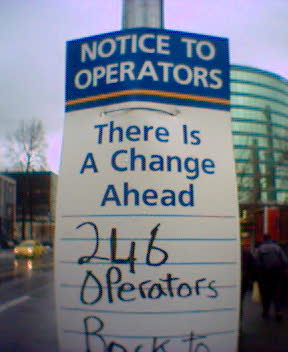 The axiom that the only thing constant is change certainly applies in the practice of bankruptcy law. Our client’ s life changes and we’re looking to dismiss a case or convert a case to another chapter.
The axiom that the only thing constant is change certainly applies in the practice of bankruptcy law. Our client’ s life changes and we’re looking to dismiss a case or convert a case to another chapter.
The code deals with this. Section 348 addresses the effect of conversion; 349 follows with the effect of dismissal. These sections provide the “what happens” when a case converts or is dismissed. But the “how” these things are accomplished is less obvious.
Michelle Kainen pointed out the very helpful synopsis of procedures in the Vermont bankruptcy courts. Practice may not be precisely the same everywhere, but this outline will get you started with the code sections and the rules that govern. As always, check your local rules.
United States Bankruptcy Court
District of Vermont
SYNOPSIS OF U.S. BANKRUPTCY CODE AND RULES REGARDING
CONVERSION AND DISMISSAL OF CHAPTER 7 AND 13 CASES
CONVERSIONS FROM CHAPTER 7 TO CHAPTER 13 (11 U.S.C. § 706)
1. By the Debtor. Debtor can convert from Chapter 7 to 13 only if Debtor (i) is eligible for Chapter 13 relief,
and (ii) can demonstrate that the conversion is in good faith.
a. Done by MOTION (Rule 1017(f)(2)); default procedure can be used.
b. Minimum 21 days’ notice to be provided to all parties and creditors (Rule 2002(a)(4)).
c. No fee.
2. By a Party in Interest. A party in interest may not request conversion from Chapter 7 to Chapter
13 UNLESS Debtor consents to conversion and is eligible to be a debtor under Chapter 13. If
such criteria are met, the following procedures apply:
a. Done by MOTION.
b. Notice to all creditors;
c. debtor must consent;
d. No fee.
FROM CHAPTER 7 TO CHAPTER 11, or 12 (11 U.S.C. § 706)
1. By the Debtor. Debtor has an absolute right to convert from Chapter 7 to Chapter 11, or Chapter 12 at any
time PROVIDED that the case has not been previously converted and the Debtor is eligible to be a debtor
under that Chapters 11 or 12 (see §§ 706(d) and 109).
a. Done by MOTION (Rule 1017(f)(2)); default procedure can be used where there has NOT been a
previous conversion.
b. Notice to Office of U.S. Trustee (UST) and Chapter 7 trustee, but no hearing required;
c. Fee required (refer to “Bankruptcy Court Fees” under the “Legal Resource Page” on the
Court’s website, http://www.vtb.uscourts.gov).
2. By a Party in Interest. Practically speaking, the only available relief to seek is conversion to
Chapter 11 since conversion to Chapter 12 is available at the Debtor’s request or upon Debtor’s
consent. (Refer to procedure outlined in previous paragraph.)
a. Done by MOTION (see Rule 1017(f)(1)); default procedure can be used;
b. Minimum 21 days’ notice required to all parties and creditors (see Rule 2002(a)(4));
c. Fee required (refer to “Bankruptcy Court Fees” under the “Legal Resource Page” on the
Court’s website, http://www.vtb.uscourts.gov).
FROM CHAPTER 13 TO CHAPTER 7 (11 U.S.C. § 1307)
1. By the Debtor. Debtor can convert from Chapter 13 to Chapter 7 at any time. Debtor has absolute right to
this relief (no exceptions in this District).
a. Done by NOTICE OF CONVERSION (Rule 1017(f)(3)).
b. No order required (n.b., the order issued by the Court addresses the Debtor’s duties upon
conversion; it is not an approval or granting of conversion);
c. $25 conversion fee paid at time of filing of the notice. Clerk’s Office will issue a bill if the fee is not
paid with the filing.
2. By a Party in Interest or UST. Party seeking conversion must demonstrate cause for conversion
(see § 1307(c) (providing non-exclusive list of examples of cause)), EXCEPT that a farmer cannot
be forced from Chapter 13 to Chapter 7.
a. Done by MOTION; default procedure can be used.
b. Minimum 21 days’ notice required to all parties and creditors (see Rule 2002(a)(4));
c. $15 conversion fee payable at time of filing of the notice; Clerk’s Office will issue a bill if the
fee is not paid with the filing.
Note: If multiple motions to convert are filed, the $25.00 fee is due for each motion. However, if several
parties join in a single motion to convert, only one fee is due.
DISMISSALS
Note: There is no fee payable for the filing of a motion to dismiss.
CHAPTER 7 CASE (11 U.S.C. § 707)
Case can be dismissed only after notice and hearing and only for (i) cause (see § 707(a) (setting forth
three grounds for dismissal), or (ii) substantial abuse (see § 707(b)).
• Done by MOTION; default procedure can be used;
• Minimum 21 days’ notice required to all parties and creditors, EXCEPT if motion is
brought under § 707(b) or based upon failure to pay filing fee (see Interim Rule
2002(a)(4)).
• Waiver of minimum notice if seeking dismissal for:
failure to pay filing fee (§ 707(a)(2));
failure to file schedules and statements (§ 707(a)(3));
motion based on UST’s § 707(b) motion.CHAPTER 13 CASE (11 U.S.C. § 1307)
1. By the Debtor. Debtor can dismiss his/her Chapter 13 case at any time. Debtor has absolute right to this relief
PROVIDED that the case has not been previously converted.
a. Done by MOTION (Rule 1017(f)2)).
b. No hearing required, but UST and Chapter 13 Trustee are to be served (Rule 1017(a)).
2. By a Party in Interest or UST. After notice and hearing, the case may be dismissed for cause
(see § 1307(c) (providing non-exclusive list of examples of cause)) PROVIDED the Court deems
it to be in the best interest of the creditors.
a. Done by MOTION; default procedure can be used..
b. 21 days’ notice required to all parties and creditors (Rule 2002(a)(4)).
My thanks to Jill Michaux who made sure I didn’t miss this gem.
Image courtesy of Uncleweed.








perhaps you could have included some commentary regarding the various schedules that need to be filed upon conversion. for example, conversion in either direction requires an appropriate means test be filed (although in ND CA apparently this is not required), a statement of intent will need to be filed when going from 13 to 7 and almost certainly an amended I & J when going in either direction.
My focus here was on how to effect that change, not what you have to do thereafter. Gotta save something to write about next week
You just copied the statute?
No, I copied the Vermont court’s synopsis so you wouldn’t have to dig it out on their site.